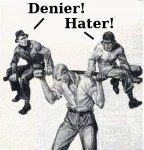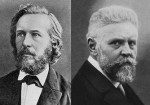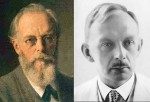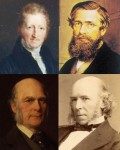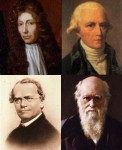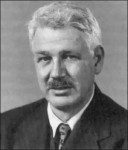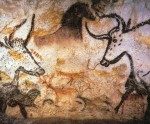
Continued reading from William Pierce’s Who We Are:
Upper Paleolithic Man
For roughly 20,000 years during the closing chapter of the Ice Ages — the period known to archaeologists as the Upper Paleolithic, or “late old stone age” — our ancestors lived as big-game hunters in Europe, ranging from the Mediterranean coast to the edge of the ice in the north. Their physical remains and those of their artifacts are relatively plentiful, giving us a great deal of information about them and their lifestyle. One of the most striking things about the Upper Paleolithic inhabitants of Europe was their physical homogeneity. Measurements made on their skeletal remains indicate a population more racially homogeneous than that of any European country today — and this population was spread over an enormous area throughout a span of time very long compared to that of all recorded human history.
As one would expect, the evidence of their art indicates a corresponding degree of psychic homogeneity. A remarkable similarity exists, for example, in cave paintings found at locations ranging from the Iberian peninsula all the way to the Urals, a distance of more than 3,000 miles.
Rugged, Brainy
Upper Paleolithic Whites had broad, rugged faces with large, wide jaws, prominent chins, and — judging from the nasal openings in their skulls — prominent noses of narrow-to-medium width. And they had large brains: nearly 100 cubic centimeters larger than the White average today.
They were predominantly dolichocephalic (long-headed, like modern Nordics and Mediterraneans), although this was one physical trait in which the Upper Paleolithic population showed substantial diversity, with a larger minority of mesocephalic and brachycephalic (round-headed, like modern Alpines) skulls in the west than in the east. Throughout the Upper Paleolithic this White proto-race lived not only in Europe but also in a band stretching across northern Asia to the Pacific. In Siberia and other eastern regions they were eventually displaced or absorbed by Mongoloid peoples, although isolated pockets of them have survived even until the present (the Ainu people of Japan seem to be an example, but even they show Mongoloid admixture).
Glacial Retreat
In Europe, when the Ice Ages came to an end, some of the White big-game hunters changed their way of life, and some did not, but instead followed the retreating glaciers northward as they shrank back toward their nucleus in the mountains of the Scandinavian peninsula.
Neither the Nordics nor the Alpines of today are physically identical to the Upper Paleolithic Whites, although both are ultimately related to them. In both the Nordic and the Alpine areas of Europe, however, one finds local populations which are essentially Upper Paleolithic in type. By selecting from these populations individuals whose skeletal measurements fit those of Upper Paleolithic fossils, we can gain a good idea of what the Ice Age hunters of 25,000 years ago looked like.
And from their artifacts we can gain a good idea of how they lived. Most of these artifacts are tools or weapons made of bone or stone, but there are also carved art-objects, paintings, hearths, and remnants of dwellings.
Craftsmen and Artists
They made a great variety of stone implements, prominent among which were long, thin blades struck from carefully prepared stone cores with a single, precise blow. Such stone blades were not entirely unknown during the preceding, Neanderthal stage of human development, but now they became much more common, and the tool-making technology associated with them took several strides forward.
Another distinguishing feature of Upper Paleolithic European culture was the extensive use of bone. It was carved into sewing needles, clothing fastenings and ornaments, statuettes, harpoon and spear heads, musical instruments, and many other items, using stone tools manufactured especially for the purpose.
The Upper Paleolithic economy was based on herd animals: horses, woolly mammoths, bison, and, especially, reindeer. These animals flourished on the tundra, and the people of Europe depended almost totally on them. From their flesh came food, from their hides clothing and coverings for shelters, and from their bones tools and implements.
Permanent Villages
Some groups of hunters apparently followed the herds on their seasonal migrations, but others established year-around settlements. Typically these settlements were occupied by from five to 20 families (from 20 to 100 individuals), and the habitations varied from single-family huts, probably covered with animal skins, to long, multi-family houses with gable roofs. One such Ice Age long house in southern Russia was nearly 450 feet long. Despite the harsh environment, the tundra supported large herds, and the hunters apparently had plenty to eat. They obviously had the leisure time — and the inclination — to devote themselves to non-essential pastimes, such as art and music.
Birth of Ceramics
These Ice Age Europeans were inventive people. In a few thousand years they introduced more cultural innovations than in all of mankind’s previous existence. They learned, for example, to use coal as a fuel. And they learned that by firing statuettes and other objects molded of clay, they obtained a much more durable. water-resistant product. Fired-clay objects recently found at Dolni Vestonice, in Moravia, and dated at 28,000 years ago represent man’s first use of the ceramic techniques which played such an important role in his later cultural development. Until quite recently, archaeologists had assumed that ceramic technology was first developed by farming peoples in the Middle East almost 20,000 years later.
There is also evidence that the Ice Age hunters carried on trade over distances of hundreds of miles, at least.
Ice-Age Archers
Two enormously significant inventions which date from the closing phase of the Wuerm Ice Age are the spear-thrower and the bow. Approximately 15,000 years ago Upper Paleolithic Whites learned to throw a hunting spear with much greater force by using the leverage provided by a piece of carved reindeer antler hooked over the butt. This invention gradually spread over the world, and the racially backward Australian aborigines still use spear-throwers for hunting today.
Some 11,000 years ago our European ancestors invented the world’s second propulsive weapon, the bow. Although the earliest bow which has been found (at Holmgard, Denmark) is only about 8,000 years old, collections of arrows 3,000 years older, with clearly identifiable notches for a bowstring, have been unearthed at Stellmoor, near Hamburg. The bow gave man an incalculable advantage in hunting, as he no longer had to creep up on his prey to within spear range.
Two gaps in Upper Paleolithic man’s cultural achievements are primarily responsible for the limitations in our knowledge of him and his ways: he did not write, and he seldom portrayed human beings in his prolific art.
Our First Kinsmen
Whether neoteny provides the correct explanation for the developments of the Upper Paleolithic period or not, it is clear that the race which hunted reindeer on the tundra of northern Europe from the second Wuerm glacial advance until about 10,000 years ago was essentially modern, not only physically but also psychically, and was, therefore, the first race to appear on this earth with whom we can feel the bond of full kinship.
Until now we have traced the development of a single, rather homogeneous racial group: the Whites of the Upper Paleolithic period who hunted the herds on the northern Eurasian plain, and their forest-and-coast-dwelling descendants in the Mesolithic period.
Mediterranean Subrace
But throughout the whole Upper Paleolithic period there was another subracial type on the southern and southeastern margins of Europe. Averaging about five inches shorter than the Upper Paleolithic Whites, with slenderer builds, smaller heads, narrower faces, and more delicate features, the male and female members of this southern subrace were quite similar in skeletal appearance. That is, they were a pedomorphic subrace, to use the ethnological term; the adults did not develop as strong a degree of sexual differentiation as did the Upper Paleolithic Whites. These were the ancestors of today’s small, dark, narrow faced, pedomorphic Mediterraneans.
Some 150,000 years ago, during the relatively mild Riss-Wuerm interglacial period, the ancestors of the Upper Paleolithic Whites first expanded from southern Europe into the northern Eurasian plain, as described in the third installment in this series. But some of their fellows remained behind, along both the northern and southern shores of the Mediterranean and in the Middle East. Those who went north and became big-game hunters went through the Neanderthaloid phase and eventually evolved into the Cro-Magnon type of the Upper Paleolithic. Those who remained in the south evolved under different conditions, becoming the Mediterranean type.
Upper Paleolithic
The Cro-Magnon subrace, which was the principal racial element in Europe during the Upper Paleolithic and Mesolithic periods — i.e., from about 40,000 years ago until the introduction of farming 6,000-8,000 years ago — is represented today by groups of Upper Paleolithic survivors in Ireland, northern Germany, Scandinavia, and other parts of northern Europe. They were described and pictured in the fourth installment in this series. The Cro-Magnon homeland may be considered to be the vast northern European plain, stretching from the Alps in the south to the North Sea and the Baltic Sea in the north, and from Ireland in the west to the Urals in the east.
Alpine Subrace
The Alpine subrace, which was described in the fifth installment, has been derived from the Cro-Magnon subrace through a complex of genetic changes involving a reduction in stature, a decrease in relative head length, a slight decrease in sexual differentiation — and, perhaps, some Mediterranean admixture. The Alpine homeland is the mountain belt stretching across western and central Europe – i.e., it is in that region that Alpines have historically constituted the largest portion of the population.
And the various Mediterranean types, whose ancestors developed more or less separately from the Cro-Magnon subrace, have their homelands along the African and European shores of the Mediterranean Sea and in the Middle East.
Population Explosion
When men everywhere lived by hunting, fishing, and gathering natural vegetation, population densities were everywhere quite small: on the order of one person for every five square miles of habitable land. When they began living by farming and raising livestock, however, population densities rapidly increased more than a hundredfold.
We noted in the fifth installment that it was in the Mediterranean racial area, on Europe’s borders rather than in its interior, that the Neolithic revolution began. And, thus, beginning about 9,000 years ago, the Mediterraneans gained a strong numerical advantage over the Cro-Magnons and their Alpine relatives. Several groups of Mediterraneans, representing several varieties, were able to push northward and westward into Europe, initially swamping the sparse hunter-gatherer population.
Even though the Cro-Magnons themselves experienced a population surge when they became farmers, the initial advantage of the Mediterraneans resulted in a lasting Mediterranean numerical dominance in many areas which had formerly been Cro-Magnon. Most areas of Mediterranean penetration became racially mixed, with the ratio of Cro-Magnon to Mediterranean blood varying from place to place.
Tall, Blond Warriors
But the Mediterraneans were not the only ones to invade the Cro-Magnon areas of Europe during the Neolithic period. From the steppes of southern Russia, in the region between the Black Sea and the Caspian, came wave after wave of a subrace which differed from all the others we have encountered thus far. Not quite as ruggedly built as the Cro-Magnons, yet more so than the Mediterraneans, they were tall and fair.
They may have learned the arts of agriculture from earlier contact with a nearby Mediterranean group, or they may have developed farming on their own, but, whichever the case, they were already carrying these arts westward and northwestward with them nearly 6,000 years ago. Superb craftsmen as well as farmers and cattle breeders, they were, above all else, warriors. Wherever they went they conquered and ruled.
Nordics Take Lead
And their culture ruled also. Their language replaced the language of the conquered peoples everywhere, as did also their religion, their art, and their social customs. They were the Nordics.
The Old European civilization lasted about 3,000 years — i.e., until about 5,500 years ago — and then it disintegrated utterly. Its temples and gods, its towns, its language — all disappeared in an overwhelming disaster: the arrival of Bronze Age Nordic warriors from the east.
The creators of the Old European civilization were a blend of the Mesolithic Cro-Magnons originally in the Balkan area and the Neolithic Mediterraneans who infiltrated the area, beginning a little over 8,500 years ago. Most of these Mediterraneans were of a variety anthropologists call Danubian, and they were short, gracile, and pedomorphic. Because the Cro-Magnon population differed physically in so many respects from the Danubians, there were substantial geographical variations in racial type in Old Europe, depending on the proportions of the two basic stocks present in the blend. When the Nordics arrived, the geographical racial pattern became even more varied. The racial homogeneity which had existed in most of Europe during the Upper Paleolithic period was gone for good.
Soil-Bound Spirit
The religion of the people of Old Europe, like the religion of every race, was created in their own image, a spiritual reflection of their inner nature. They were farmers, Mediterranean and passive. They were a settled race, and their ties were to the soil. Although we can decipher none of their religious inscriptions, it seems safe to assume that, like other soil-bound peoples, their religion was centered on the concept of fertility. Certainly, this is suggested by the abundance of female figurines, stylized vulva symbols, and other evidences of a flourishing fertility cult which have been unearthed by archaeologists along with other remnants of the Old European culture.
The abundance of the life-giving soil, the seasonal death and rebirth of the green earth, the mating and birthing of their domestic animals: these were the essential mysteries, and it was around these that the religious concepts of their matriarchal society must have been formed. Theirs was the religion of the Earth Mother.
Warrior Religion
In contrast, the Battle-Axe People, the blond horsemen from the east, the conquerors of Old Europe, were a race on the move. Nordic, active, patriarchal, dominating, they, too, farmed and, bred livestock, but they were far less soil-bound in their outlook than the Mediterraneans. Warriors, explorers, rulers, they were less concerned with the mysteries of plant and animal reproduction and more concerned with valor, honor, and authority. Their spiritual focus was upward and outward, toward the sky and far horizons, rather than downward toward the soil and inward toward their own bodily functions, as in the case of the Mediterraneans. Theirs was the religion of the Sky Father.
Neolithic Europe, Wikipedia:
Basic cultural characteristics
Regardless of specific chronology, many European Neolithic groups share basic characteristics, such as living in small-scale, presumably egalitarian [citation needed], family-based communities, subsisting on domesticated plants and animals supplemented with the collection of wild plant foods and with hunting, and producing hand-made pottery, that is, pottery made without the potter’s wheel. There are also many differences, with some Neolithic communities in southeastern Europe living in heavily fortified settlements of 3,000-4,000 people (e.g., Sesklo in Greece) whereas Neolithic groups in England were small (possibly 50-100 people) and highly mobile cattle-herders.
The details of the origin, chronology, social organization, subsistence practices and ideology of the peoples of Neolithic Europe are obtained from archaeology, and not historical records, since these people left none. Since the 1970s, population genetics has provided independent data on the population history of Neolithic Europe, including migration events and genetic relationships with peoples in South Asia. A further independent tool, linguistics, has contributed hypothetical reconstructions of early European languages and family trees with estimates of dating of splits, in particular theories on the relationship between speakers of Indo-European languages and Neolithic peoples.
The podcast will be broadcast and available for download on Tuesday at 9PM ET.
Podcast: Play in new window | Download





